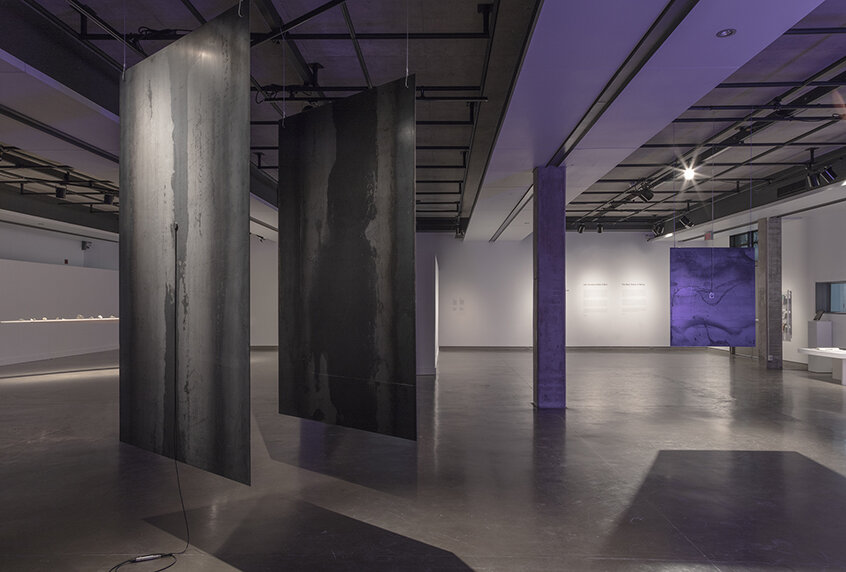

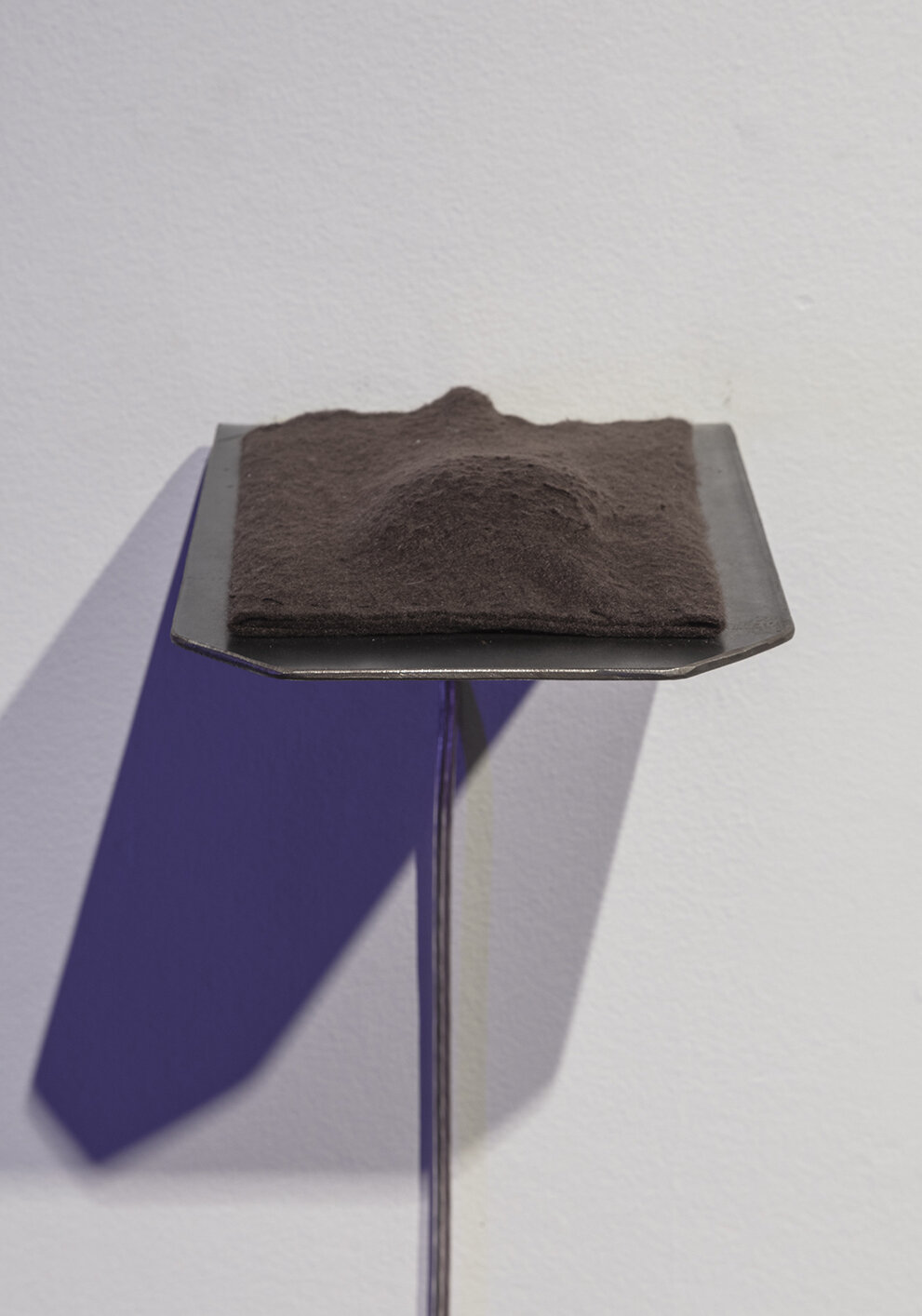
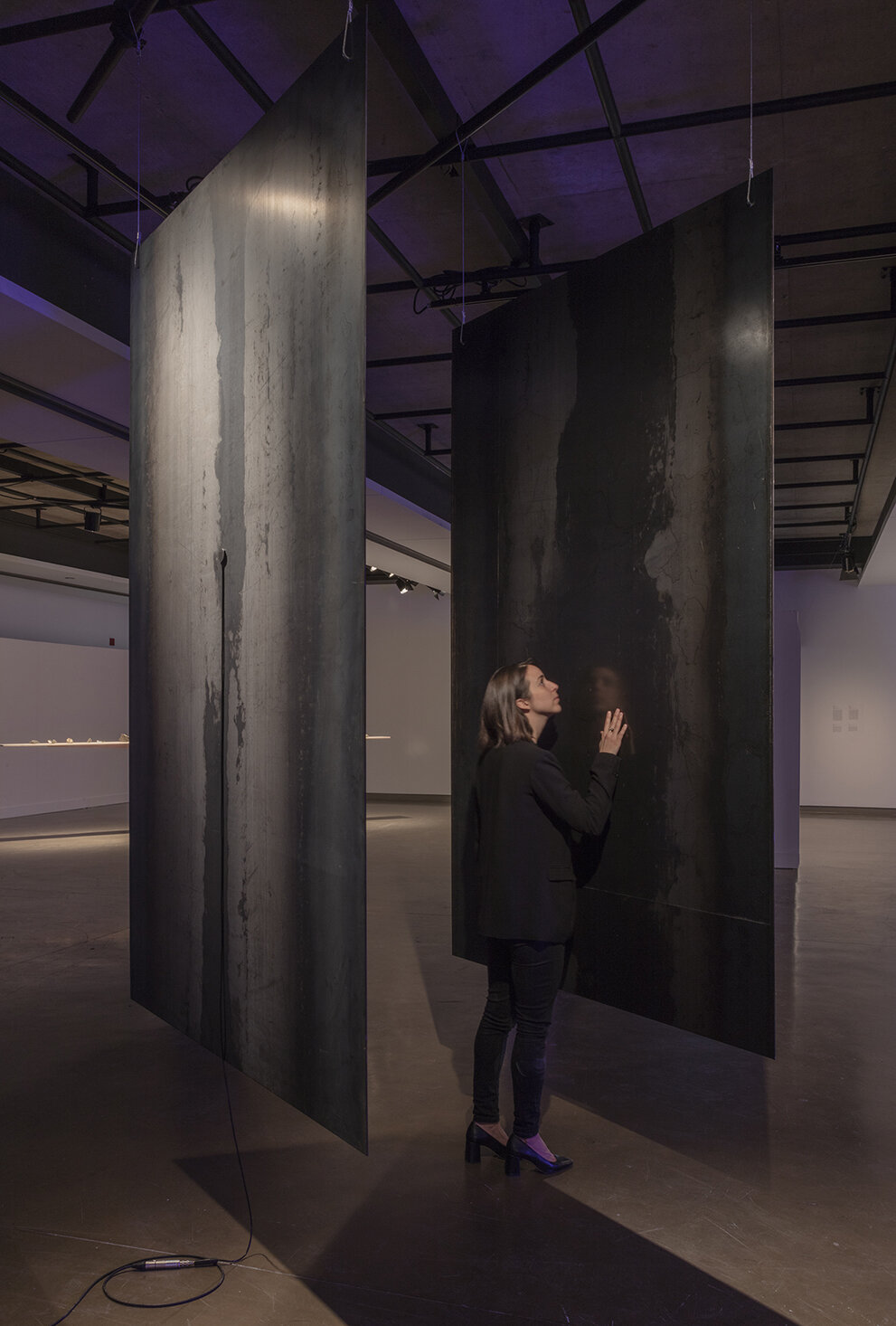
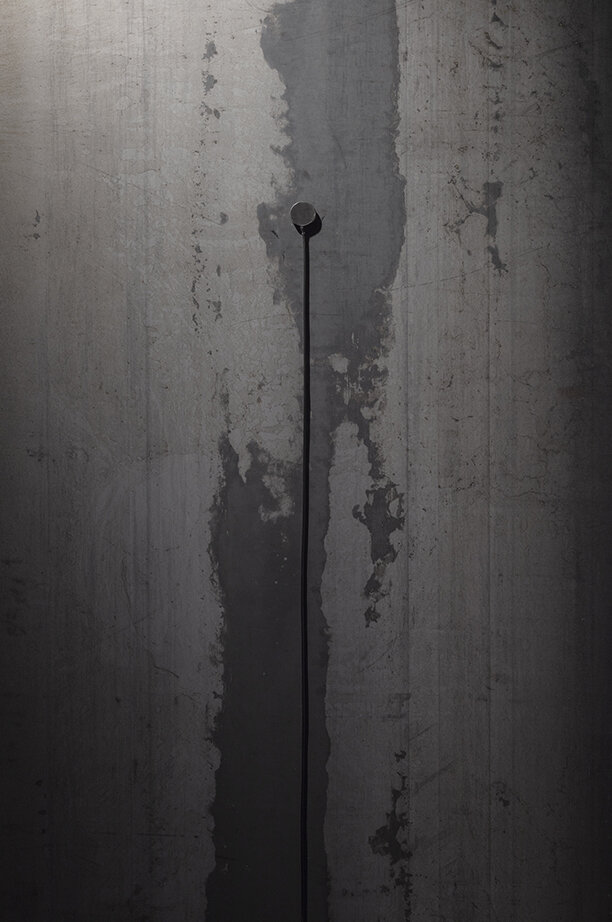
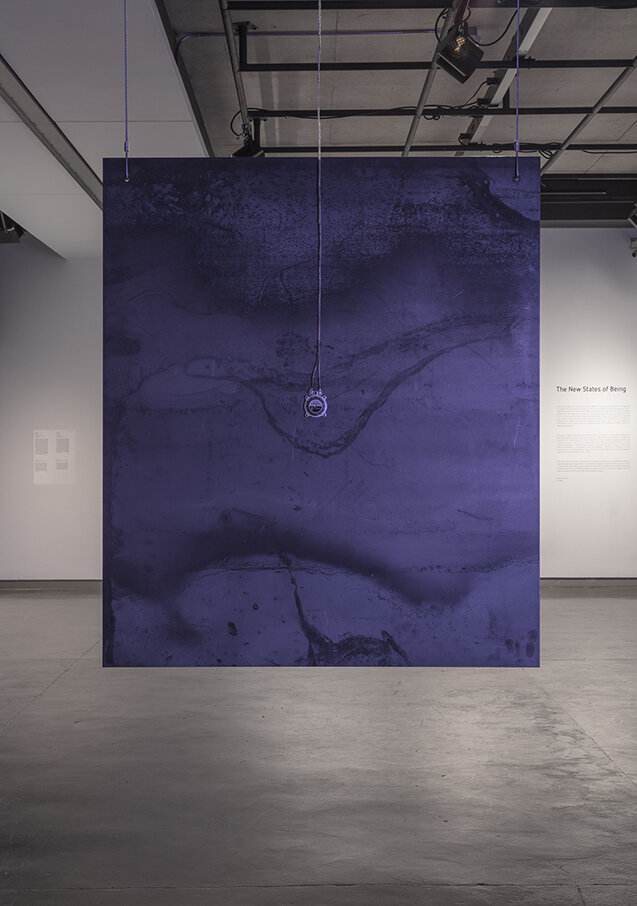
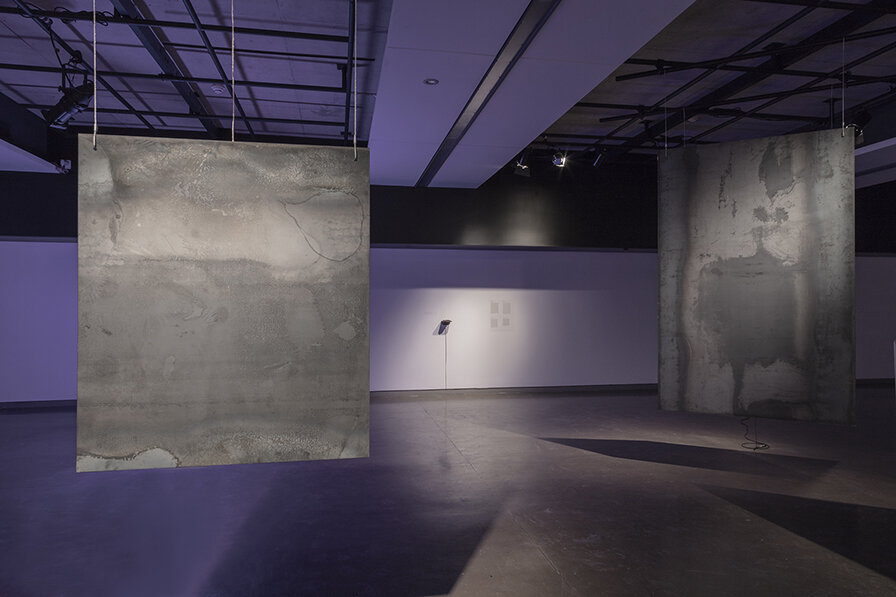
In-ouïe, 2019. Centre d’exposition de l’Université de Montréal. Exhibition The New States of Being, curated by Aseman Sabet, September 27 2019 - January 11 2020. The installation was developed in conversation with Dr. Robert Truog at the Harvard Medical School and commissioned by the research-creation project Ai-Ship - directed by Jean-Christophe Bélisle-Pipon in collaboration with the Petrie-Flom Center for Health Law Policy, Biotechnology, and Bioethics at the Harvard Law School.
In-ouïe, is a sound installation exploring the idea of Hearing as a way of touching at a distance. Sound waves are invisible and yet tangible. They touch us in a very intimate way, emotionally and physically. In order to become an active witness of this phenomenon, the two-part installation invites the visitor to experience the physicality of sound through touch, at its almost imperceptible level.
The distance between the Self and the Other, and the precise definition of this Other, takes on a particular significance in the current medical context, where the development of AI is increasingly impacting the relationship between patients and caregivers. This observation asks us to carefully consider the underlying foundations of care, which include attentive listening and an openness to compassion. Initially at the heart of the discussions between artist Sandra Volny and bioethicist Robert Truog, these concerns take form in the sound installation In-ouïe (unheard). This two-part work features large suspended steel plates which immediately suggest an industrial presence, reminiscent of the sphere of robotics. Interacting at a human scale, one of the metal panels—to which an acoustic transducer has been attached—occasionally asks viewers “Who are you?” Coming out of an inert material, this impersonal voice, neither synthetic nor quite human, asks a fundamental question that leads us to consider our own identity just as much as its identity. The voice’s resonance changes according to our position in the space, and in doing so it encourages us to reflect on what differentiates us from that incarnation. When applied to the new forms of relationships created by AI in health, this seemingly simple question takes on an essential tone: Is a patient’s identity nothing more than a database these days? Who is in charge of caring for us, medical practitioners or machines? The introspective experience stimulated by this segment of the work is mirrored by the interoceptive experience encountered in the second part. Two imposing steel plates are suspended facing each other, forming a narrow passage: passing through this vertical gap means risking physical contact with the flat surfaces. Within its confines, our voice resonates differently, we perceive our environment differently. Acting as an interface between space, sound and the body, these floating panels—one of which is equipped with a contact mic—are concretely echoed by a small device which holds a transducer a few meters away. By placing a hand on the latter, the soundscape and vibrations affecting the two steel surfaces resonates throughout the body, prompting a sensory perception that is internal, intimate and undeniably sensible. The idea of touching at a distance connects with that of being touched (in the figurative sense) and acts as an experiential metaphor for empathy.
Text by Aseman Sabet.
Leadership Team
Jean-Christophe Bélisle-Pipon, PhD
Nathalie Voarino, MA
Glenn Cohen, JD
Collaborators Vincent Couture, PhD
Vardit Ravisky, PhD
Marc-Antoine Dilhac, PhD
Exhibition Curated By
Aseman Sabet
Exhibition Dates Centre d’exposition de l’Université de Montréal, Montréal, Canada. Sept 27 -Jan 11, 2020
TBA. Boston, Spring 2021
TBA. Geneva, Fall 2022
Documentation of the exhibition at Centre d’Exposition de l’Université de Montréal, 2019.
La distance entre le Soi et l’Autre, et la définition même de ce qu’est cet Autre, deviennent particulièrement significatives dans le contexte médical actuel où le développement de l’IA affecte de plus en plus la relation entre patients et soignants. Suivant ce constat, il importe de considérer de plus près les fondements du soin, impliquant une écoute profonde et une ouverture à la compassion. Initialement au cœur des échanges entre l’artiste Sandra Volny et le bioéthicien Robert Truog, ces préoccupations prennent forme dans l’installation sonore In-ouïe (unheard). Composée en deux volets, l’œuvre met de l’avant de grandes plaques d’acier suspendues qui engagent d’office une présence industrielle, renvoyant au détour à l’univers de la robotique. Dialoguant avec l’échelle humaine, une de ces parois métalliques – auquel a été rattaché un transducteur – s’adresse ponctuellement au spectateur : « Who are you ? » (Qui êtes-vous ?). Prenant corps dans ce matériau inerte, cette voix impersonnelle, ni synthétique ni proprement humaine, exprime une interrogation fondamentale qui porte à une considération sur notre identité autant que sur la sienne. Elle encourage ainsi une réflexion sur ce qui nous différencie de cette incarnation dont les résonnances multiples varient selon notre position dans l’espace. Transposée dans le cadre des nouvelles modalités relationnelles suscitées par l’IA en santé, cette question en apparence simple apparaît comme essentielle : l’identité du patient se réduit-elle aujourd’hui à un ensemble de data? Qui du médecin ou de la machine est en charge de nous soigner? Stimulant une expérience introspective, ce pan de l’installation trouve écho dans un second volet qui invite cette fois à une expérience intéroceptive. Deux imposantes plaques d’acier sont suspendues face à face. L’espace qui les distancie offre un passage, mais est suffisamment serré pour solliciter des contacts physiques avec leurs surfaces planes. Dans cet interstice vertical, notre voix résonne autrement, on perçoit notre environnement autrement. Agissant comme des interfaces entre l’espace, le corps et le son, ces parois flottantes – dont l’une est munie d’un microphone contact – trouvent concrètement écho dans un petit dispositif installé à quelques mètres de distance et comprenant un transducteur. En y apposant notre main, le paysage sonore et vibratoire entourant et affectant les deux surfaces en acier résonne à travers le corps, engageant ainsi une perception sensorielle interne, intime et d’une indéniable portée sensible. L’idée de toucher à distance rejoint alors celle d’être touché (au sens figuré) et agit comme une métaphore expérientielle de l’empathie.
Texte de Aseman Sabet.
